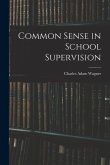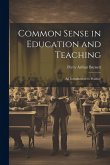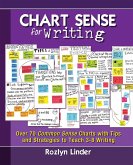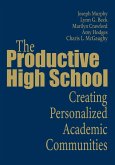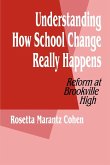- Broschiertes Buch
- Merkliste
- Auf die Merkliste
- Bewerten Bewerten
- Teilen
- Produkt teilen
- Produkterinnerung
- Produkterinnerung
This updated bestseller offers more than 70 easy-to-implement classroom strategies with new tips for handling standardized testing, Internet safety, classroom hygiene, parent-teacher relationships, and more!
Andere Kunden interessierten sich auch für
![Common Sense in School Supervision Common Sense in School Supervision]() Charles Adam WagnerCommon Sense in School Supervision23,99 €
Charles Adam WagnerCommon Sense in School Supervision23,99 €![Commitment and Common Sense Commitment and Common Sense]() David P DriscollCommitment and Common Sense37,99 €
David P DriscollCommitment and Common Sense37,99 €![Common Sense in Education and Teaching: An Introduction to Practice Common Sense in Education and Teaching: An Introduction to Practice]() Percy Arthur BarnettCommon Sense in Education and Teaching: An Introduction to Practice26,99 €
Percy Arthur BarnettCommon Sense in Education and Teaching: An Introduction to Practice26,99 €![Spend Your Way to Wealth: Seven Common Sense Steps To Black Prosperity Spend Your Way to Wealth: Seven Common Sense Steps To Black Prosperity]() Jean BonhommeSpend Your Way to Wealth: Seven Common Sense Steps To Black Prosperity22,99 €
Jean BonhommeSpend Your Way to Wealth: Seven Common Sense Steps To Black Prosperity22,99 €![Chart Sense for Writing Chart Sense for Writing]() Rozlyn LinderChart Sense for Writing29,99 €
Rozlyn LinderChart Sense for Writing29,99 €![The Productive High School The Productive High School]() Joseph MurphyThe Productive High School44,99 €
Joseph MurphyThe Productive High School44,99 €![Understanding How School Change Really Happens Understanding How School Change Really Happens]() Rosetta Marantz CohnUnderstanding How School Change Really Happens33,99 €
Rosetta Marantz CohnUnderstanding How School Change Really Happens33,99 €-
-
-
This updated bestseller offers more than 70 easy-to-implement classroom strategies with new tips for handling standardized testing, Internet safety, classroom hygiene, parent-teacher relationships, and more!
Hinweis: Dieser Artikel kann nur an eine deutsche Lieferadresse ausgeliefert werden.
Hinweis: Dieser Artikel kann nur an eine deutsche Lieferadresse ausgeliefert werden.
Produktdetails
- Produktdetails
- Verlag: Corwin
- 2. Auflage
- Seitenzahl: 154
- Erscheinungstermin: 12. April 2006
- Englisch
- Abmessung: 280mm x 216mm x 9mm
- Gewicht: 406g
- ISBN-13: 9781412917223
- ISBN-10: 1412917220
- Artikelnr.: 22281771
- Herstellerkennzeichnung
- Libri GmbH
- Europaallee 1
- 36244 Bad Hersfeld
- gpsr@libri.de
- Verlag: Corwin
- 2. Auflage
- Seitenzahl: 154
- Erscheinungstermin: 12. April 2006
- Englisch
- Abmessung: 280mm x 216mm x 9mm
- Gewicht: 406g
- ISBN-13: 9781412917223
- ISBN-10: 1412917220
- Artikelnr.: 22281771
- Herstellerkennzeichnung
- Libri GmbH
- Europaallee 1
- 36244 Bad Hersfeld
- gpsr@libri.de
Jill A. Lindberg retired from Milwaukee Public Schools in June 2003 and is currently a supervising teacher for the University of Wisconsin-Milwaukee. Her teaching experience includes six years as a mentor teacher, assisting both general and special education teachers in Milwaukee Public Schools. She has taught students with specific learning disabilities, students with emotional/behavior disabilities, and students with hearing impairment. She has coauthored five books in the Common-Sense Classroom Management series with educators from the Milwaukee area. She has a degree in exceptional education from the University of Wisconsin-Milwaukee.
Foreword by Christine Kadow
Preface
Acknowledgments
About the Authors
1. Taking Care of Teacher Business
Room Organization
Teacher Desk Organization
Planning
Independent Activities While Teacher Works with Small Groups
Reviewing Expectations
Field Trips
Making the Most of Your Paraprofessional Assistant
2. Creating a Positive Classroom Atmosphere
Classroom Seating
Decorating With Themes
Classroom Monitors and Jobs
Respect in Your Classroom
Teaching Social Skills
Ways to Include All Students in Classroom Participation
Super Student of the Week
Classroom Meetings
Compliment Book
Wall of Fame
Tattling
3. Communicating With Parents
Parent-Teacher Relationships
Parent Conferences
Using Email With Parents
Using Cell Phones With Parentsl
Classroom Newsletters
4. Helping Parents Teach Children Safe Internet Practices
The Information Superhighway: Basic Information for Parents
Limiting Children to Appropriate Internet Content
More Tips for Safe Traveling
Using the Internet for School Projects
5. Working With Diverse Student and Family Populations
Working With Non-English-Speaking Students
Making Non-English-Speaking Students Comfortable in Your Classroom
Working With Non-English-Speaking Families
Working With Family Members Who May Be Illiterate
6. Dealing With Personal Hygiene Issues
Recognizing That a Problem Exists
Talking to Your Class
Talking With Parents
Providing Personal Care at School
Working With Support Staff
7. With-it-ness
Teacher Behaviors
Planning Ahead and Lesson Expectations
If a Lesson Really Isn't Working
Looks, Gestures, Posture, and Positioning in Room to Convey Expectations
Demeanor and Actions During Lessons to Ensure Student Focus
Modeling Expected Responses
The Challenging Student
8. Transitioning
One Subject to Another
One Subject to Another: Moving Within the Room
Moving for Group Learning Activities
One Classroom to Another
9. Taking Care of Classroom Business
Entering School
Entering the Classroom
Beginning the Day
Absenteeism
Homework Collection
Failure to Do Homework
Line Order
Bathroom Procedure
Drinks
Pencil Sharpening
Gum, Candy, and Other Forbidden Edibles
Classroom Rules
Indoor Recess
Reentering the Classroom After Lunch and Recess
Ending the Day
10. Integrating Into Your School Culture
Becoming Part of the Team
Teacher Buddies and Mentors
To Socialize or Not to Socialize
The Teachers¿ Room
Ask for Help; Offer to Help
Other Supports for New Teachers
11. Preparing Your Students for Standardized Testing
Before the Test
Testing Day
After the Test
Test-Taking Tips for Students
12. Organizational Time
Desk Cleaning
Supplies
Mailboxes
Non-School-Related Materials
13. Rewards
Academic Rewards
Extra Special Class Time
Extra Art Time and Extra Gym Time
Leisure Time Activities
Lunch With the Teacher
Good News Phone Calls
Extra Classroom Chores
Whole-Class Rewards
Making Arrangements for Non-Reward Earners
Stickers, Stamps, and Other Goodies
Coupons
Certificates
Tokens and Play Money
Edibles
14. Consequences
Identifying Challenging Students
Dealing with Mildly Challenging Behavior
Working with Chronic, Highly Disruptive Behavior
Suggested Readings
Index
Preface
Acknowledgments
About the Authors
1. Taking Care of Teacher Business
Room Organization
Teacher Desk Organization
Planning
Independent Activities While Teacher Works with Small Groups
Reviewing Expectations
Field Trips
Making the Most of Your Paraprofessional Assistant
2. Creating a Positive Classroom Atmosphere
Classroom Seating
Decorating With Themes
Classroom Monitors and Jobs
Respect in Your Classroom
Teaching Social Skills
Ways to Include All Students in Classroom Participation
Super Student of the Week
Classroom Meetings
Compliment Book
Wall of Fame
Tattling
3. Communicating With Parents
Parent-Teacher Relationships
Parent Conferences
Using Email With Parents
Using Cell Phones With Parentsl
Classroom Newsletters
4. Helping Parents Teach Children Safe Internet Practices
The Information Superhighway: Basic Information for Parents
Limiting Children to Appropriate Internet Content
More Tips for Safe Traveling
Using the Internet for School Projects
5. Working With Diverse Student and Family Populations
Working With Non-English-Speaking Students
Making Non-English-Speaking Students Comfortable in Your Classroom
Working With Non-English-Speaking Families
Working With Family Members Who May Be Illiterate
6. Dealing With Personal Hygiene Issues
Recognizing That a Problem Exists
Talking to Your Class
Talking With Parents
Providing Personal Care at School
Working With Support Staff
7. With-it-ness
Teacher Behaviors
Planning Ahead and Lesson Expectations
If a Lesson Really Isn't Working
Looks, Gestures, Posture, and Positioning in Room to Convey Expectations
Demeanor and Actions During Lessons to Ensure Student Focus
Modeling Expected Responses
The Challenging Student
8. Transitioning
One Subject to Another
One Subject to Another: Moving Within the Room
Moving for Group Learning Activities
One Classroom to Another
9. Taking Care of Classroom Business
Entering School
Entering the Classroom
Beginning the Day
Absenteeism
Homework Collection
Failure to Do Homework
Line Order
Bathroom Procedure
Drinks
Pencil Sharpening
Gum, Candy, and Other Forbidden Edibles
Classroom Rules
Indoor Recess
Reentering the Classroom After Lunch and Recess
Ending the Day
10. Integrating Into Your School Culture
Becoming Part of the Team
Teacher Buddies and Mentors
To Socialize or Not to Socialize
The Teachers¿ Room
Ask for Help; Offer to Help
Other Supports for New Teachers
11. Preparing Your Students for Standardized Testing
Before the Test
Testing Day
After the Test
Test-Taking Tips for Students
12. Organizational Time
Desk Cleaning
Supplies
Mailboxes
Non-School-Related Materials
13. Rewards
Academic Rewards
Extra Special Class Time
Extra Art Time and Extra Gym Time
Leisure Time Activities
Lunch With the Teacher
Good News Phone Calls
Extra Classroom Chores
Whole-Class Rewards
Making Arrangements for Non-Reward Earners
Stickers, Stamps, and Other Goodies
Coupons
Certificates
Tokens and Play Money
Edibles
14. Consequences
Identifying Challenging Students
Dealing with Mildly Challenging Behavior
Working with Chronic, Highly Disruptive Behavior
Suggested Readings
Index
Foreword by Christine Kadow
Preface
Acknowledgments
About the Authors
1. Taking Care of Teacher Business
Room Organization
Teacher Desk Organization
Planning
Independent Activities While Teacher Works with Small Groups
Reviewing Expectations
Field Trips
Making the Most of Your Paraprofessional Assistant
2. Creating a Positive Classroom Atmosphere
Classroom Seating
Decorating With Themes
Classroom Monitors and Jobs
Respect in Your Classroom
Teaching Social Skills
Ways to Include All Students in Classroom Participation
Super Student of the Week
Classroom Meetings
Compliment Book
Wall of Fame
Tattling
3. Communicating With Parents
Parent-Teacher Relationships
Parent Conferences
Using Email With Parents
Using Cell Phones With Parentsl
Classroom Newsletters
4. Helping Parents Teach Children Safe Internet Practices
The Information Superhighway: Basic Information for Parents
Limiting Children to Appropriate Internet Content
More Tips for Safe Traveling
Using the Internet for School Projects
5. Working With Diverse Student and Family Populations
Working With Non-English-Speaking Students
Making Non-English-Speaking Students Comfortable in Your Classroom
Working With Non-English-Speaking Families
Working With Family Members Who May Be Illiterate
6. Dealing With Personal Hygiene Issues
Recognizing That a Problem Exists
Talking to Your Class
Talking With Parents
Providing Personal Care at School
Working With Support Staff
7. With-it-ness
Teacher Behaviors
Planning Ahead and Lesson Expectations
If a Lesson Really Isn't Working
Looks, Gestures, Posture, and Positioning in Room to Convey Expectations
Demeanor and Actions During Lessons to Ensure Student Focus
Modeling Expected Responses
The Challenging Student
8. Transitioning
One Subject to Another
One Subject to Another: Moving Within the Room
Moving for Group Learning Activities
One Classroom to Another
9. Taking Care of Classroom Business
Entering School
Entering the Classroom
Beginning the Day
Absenteeism
Homework Collection
Failure to Do Homework
Line Order
Bathroom Procedure
Drinks
Pencil Sharpening
Gum, Candy, and Other Forbidden Edibles
Classroom Rules
Indoor Recess
Reentering the Classroom After Lunch and Recess
Ending the Day
10. Integrating Into Your School Culture
Becoming Part of the Team
Teacher Buddies and Mentors
To Socialize or Not to Socialize
The Teachers¿ Room
Ask for Help; Offer to Help
Other Supports for New Teachers
11. Preparing Your Students for Standardized Testing
Before the Test
Testing Day
After the Test
Test-Taking Tips for Students
12. Organizational Time
Desk Cleaning
Supplies
Mailboxes
Non-School-Related Materials
13. Rewards
Academic Rewards
Extra Special Class Time
Extra Art Time and Extra Gym Time
Leisure Time Activities
Lunch With the Teacher
Good News Phone Calls
Extra Classroom Chores
Whole-Class Rewards
Making Arrangements for Non-Reward Earners
Stickers, Stamps, and Other Goodies
Coupons
Certificates
Tokens and Play Money
Edibles
14. Consequences
Identifying Challenging Students
Dealing with Mildly Challenging Behavior
Working with Chronic, Highly Disruptive Behavior
Suggested Readings
Index
Preface
Acknowledgments
About the Authors
1. Taking Care of Teacher Business
Room Organization
Teacher Desk Organization
Planning
Independent Activities While Teacher Works with Small Groups
Reviewing Expectations
Field Trips
Making the Most of Your Paraprofessional Assistant
2. Creating a Positive Classroom Atmosphere
Classroom Seating
Decorating With Themes
Classroom Monitors and Jobs
Respect in Your Classroom
Teaching Social Skills
Ways to Include All Students in Classroom Participation
Super Student of the Week
Classroom Meetings
Compliment Book
Wall of Fame
Tattling
3. Communicating With Parents
Parent-Teacher Relationships
Parent Conferences
Using Email With Parents
Using Cell Phones With Parentsl
Classroom Newsletters
4. Helping Parents Teach Children Safe Internet Practices
The Information Superhighway: Basic Information for Parents
Limiting Children to Appropriate Internet Content
More Tips for Safe Traveling
Using the Internet for School Projects
5. Working With Diverse Student and Family Populations
Working With Non-English-Speaking Students
Making Non-English-Speaking Students Comfortable in Your Classroom
Working With Non-English-Speaking Families
Working With Family Members Who May Be Illiterate
6. Dealing With Personal Hygiene Issues
Recognizing That a Problem Exists
Talking to Your Class
Talking With Parents
Providing Personal Care at School
Working With Support Staff
7. With-it-ness
Teacher Behaviors
Planning Ahead and Lesson Expectations
If a Lesson Really Isn't Working
Looks, Gestures, Posture, and Positioning in Room to Convey Expectations
Demeanor and Actions During Lessons to Ensure Student Focus
Modeling Expected Responses
The Challenging Student
8. Transitioning
One Subject to Another
One Subject to Another: Moving Within the Room
Moving for Group Learning Activities
One Classroom to Another
9. Taking Care of Classroom Business
Entering School
Entering the Classroom
Beginning the Day
Absenteeism
Homework Collection
Failure to Do Homework
Line Order
Bathroom Procedure
Drinks
Pencil Sharpening
Gum, Candy, and Other Forbidden Edibles
Classroom Rules
Indoor Recess
Reentering the Classroom After Lunch and Recess
Ending the Day
10. Integrating Into Your School Culture
Becoming Part of the Team
Teacher Buddies and Mentors
To Socialize or Not to Socialize
The Teachers¿ Room
Ask for Help; Offer to Help
Other Supports for New Teachers
11. Preparing Your Students for Standardized Testing
Before the Test
Testing Day
After the Test
Test-Taking Tips for Students
12. Organizational Time
Desk Cleaning
Supplies
Mailboxes
Non-School-Related Materials
13. Rewards
Academic Rewards
Extra Special Class Time
Extra Art Time and Extra Gym Time
Leisure Time Activities
Lunch With the Teacher
Good News Phone Calls
Extra Classroom Chores
Whole-Class Rewards
Making Arrangements for Non-Reward Earners
Stickers, Stamps, and Other Goodies
Coupons
Certificates
Tokens and Play Money
Edibles
14. Consequences
Identifying Challenging Students
Dealing with Mildly Challenging Behavior
Working with Chronic, Highly Disruptive Behavior
Suggested Readings
Index


